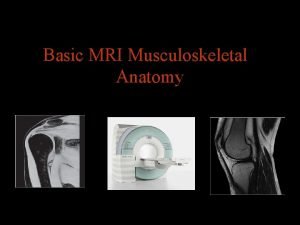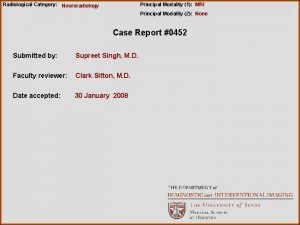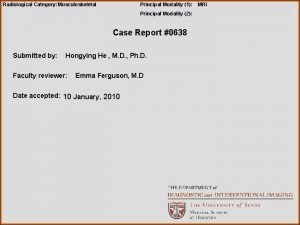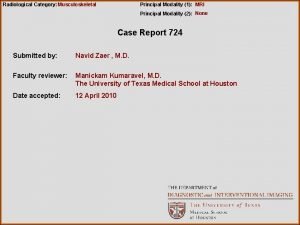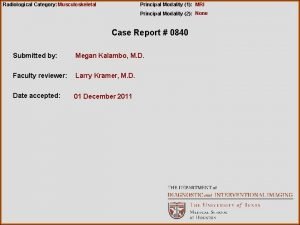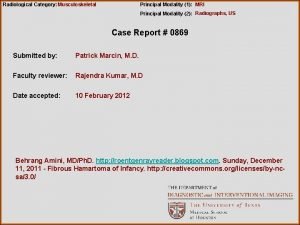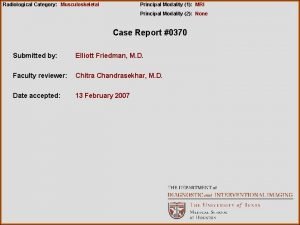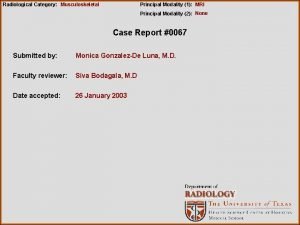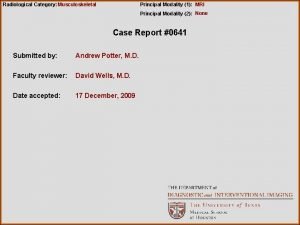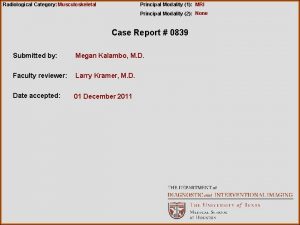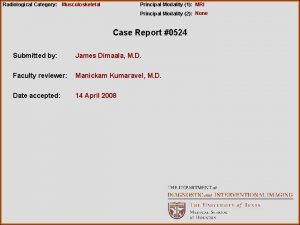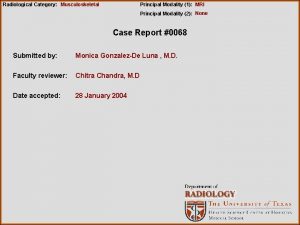Radiological Category Musculoskeletal Principal Modality 1 MRI Principal













- Slides: 13

Radiological Category: Musculoskeletal Principal Modality (1): MRI Principal Modality (2): None Case Report #0544 Submitted by: Rosalind Candelaria, M. D. Faculty reviewer: Manickam Kumaravel, M. D. Date accepted: 14 January 2009

Case History 54 year old male with pain in the right posterior hip

Radiological Presentations Figure 1: Radiographs of the right hip demonstrate no fracture nor dislocation.

Radiological Presentations Figure 2: MR sagittal PD images of the right hip demonstrate increased signal at the origin of the hamstring tendons

Radiological Presentations Figure 3: MR coronal PD images of the right hip demonstrate increased signal at the origin of the hamstring tendons

Radiological Presentations Figure 4: MR sagittal T 2 -weighted images of the right hip demonstrate increased signal at the origin of the hamstring tendons

Radiological Presentations Figure 5: MR axial T 1 -weighted images of the right hip demonstrate an intact ischial tuberosity and no abnormal bone marrow signal

Test Your Diagnosis Which one of the following is your choice for the appropriate diagnosis? After your selection, go to next page. • Hamstring tendonitis • Ischial tuberosity avulsion

Findings and Differentials Findings: RADIOGRAPHS: No fracture nor dislocation. MRI: Diffuse edema (PD and T 2 -weighted high signal intensity) at the hamstring origin. No adjacent bone marrow edema. No separate fibers with retraction. Differentials: • Hamstring tendonitis • Ischial tuberosity avulsion

Discussion The hamstring muscle complex (HMC), a frequently injured muscle, is comprised of the biceps femoris, semitendinosus, and semimembranosus muscles. These muscles serve as knee flexors and hip extensors. All three muscles originate at the ischial tuberosity. The semitendinosus muscle arises from the inferomedial upper portion of the ischial tuberosity as a conjoint tendon with the long head of the biceps femoris muscle. The semimembranosus muscle originates from the superolateral aspect of the ischial tuberosity; its tendon runs anteromedial to the other hamstring tendons. Significant causes of hamstring injuries include inadequate flexibility, inadequate strength and endurance, and muscle fatigue. Patients complain of posterior thigh pain and deep, vague buttock pain. On physical examination, pain can be elicited with resisted knee flexion and also with passive extension of the knee and the hip flexed at 90°d.

Discussion The mainstay of treatment of hamstring injuries is physical therapy, which involves a hamstring flexibility and eccentric strengthening program. The standard medication is nonsteroidal anti-inflammatory drugs (NSAIDs). Injection of corticosteroid into the tendon sheath just below the ischial attachment may be helpful in more severe cases. Rare surgical intervention may be recommended in the case of complete rupture of the proximal or distal attachment of the myotendinous complex into the bone. Magnetic resonance imaging of the hip (T 1 and T 2 -weighted images with fat saturation) demonstrates soft-tissue edema surrounding the hamstring tendon. The tendon can sometimes appear thickened. Intermediate signal may appear within the tendon, consistent with tendinopathy. Fluid in the bursa between the ischial tuberosity and the tendon may also be present. Radiographs can appear normal. Although an ischial tuberosity avulsion is in the differential diagnosis, the images involving our case demonstrate an intact ischial tuberosity and no abnormal bone marrow signal.

Diagnosis Hamstring tendonitis (sprain of the hamstring).

References JT Bencardino, ZS Rosenberg, RR Brown, A Hassankhani, ES Lustrin, and J Beltran. Traumatic Musculotendinous Injuries of the Knee: Diagnosis with MR Imaging. Radio. Graphics, 2000; 20: S 103 – S 120. AA De Smet and TM Best. MR Imaging of the Distribution and Location of Acute Hamstring Injuries in Athletes. Am. J. Roentgenol. , Feb 2000; 174: 393 - 399. G Koulouris and D Connell. Hamstring Muscle Complex: An Imaging Review. Radio. Graphics, 2005; 25: 571 – 586. P Munk and A Ryan. Teaching atlas of musculoskeletal radiology. 1 st ed. New York; Thieme, 2007; 97 – 102.
 Musculoskeletal mri anatomy
Musculoskeletal mri anatomy Erate category 2 eligible equipment
Erate category 2 eligible equipment Radiological dispersal device
Radiological dispersal device Tennessee division of radiological health
Tennessee division of radiological health Center for devices and radiological health
Center for devices and radiological health National radiological emergency preparedness conference
National radiological emergency preparedness conference Mri principal
Mri principal Cardinality and modality
Cardinality and modality Modality erd
Modality erd Modality in software engineering
Modality in software engineering Epistemic modality
Epistemic modality Diagnostics imaging
Diagnostics imaging Modality in statistics
Modality in statistics Past tense in xhosa
Past tense in xhosa
